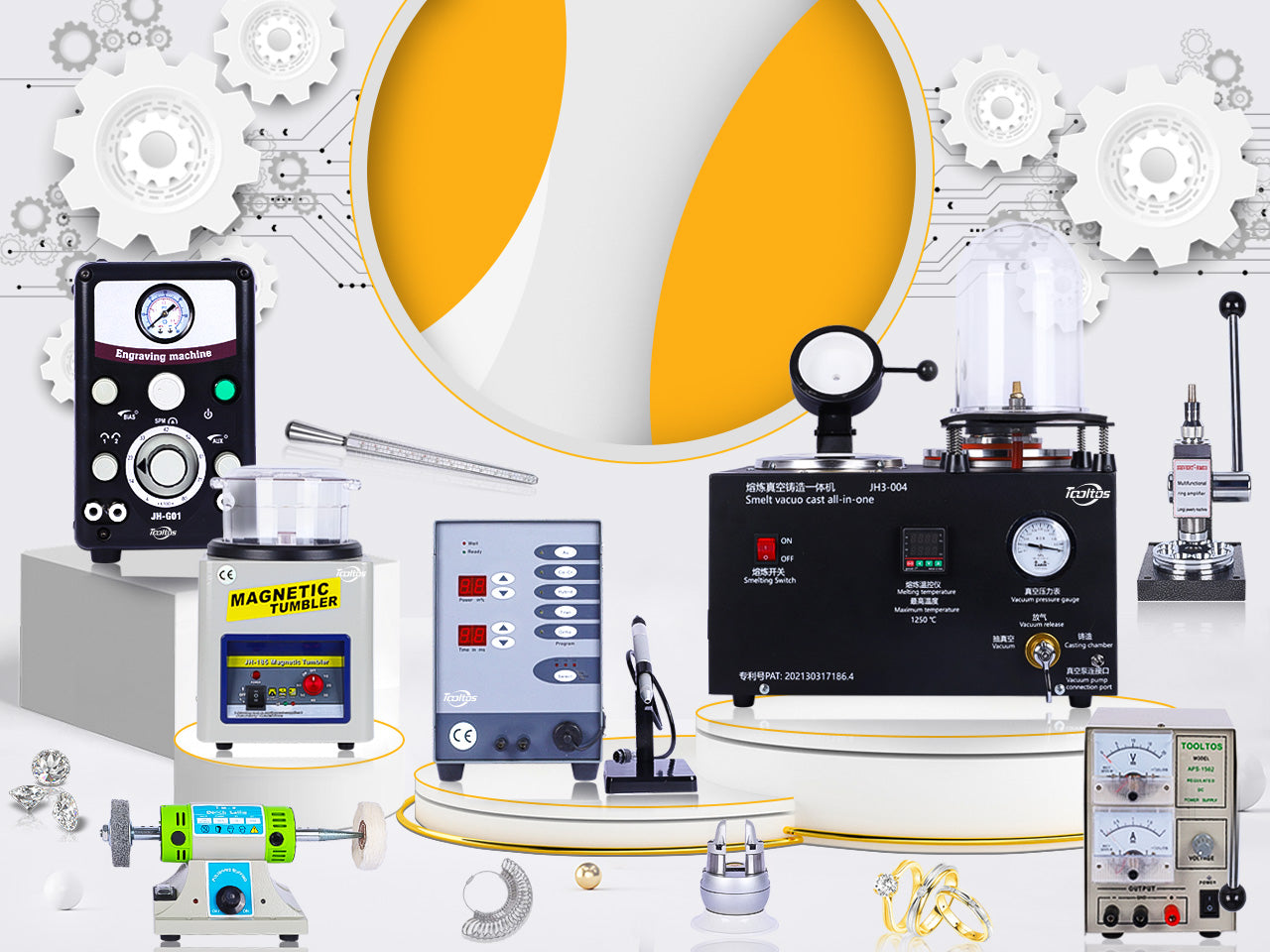If you're used to traditional metalwork, adapting to a process like wax carving may feel like a challenge at first. When making metal jewelry, you usually add decorative elements to the base piece, whether it's adding gemstones or decorative gallery strips. But when it comes to wax-carved jewelry, the opposite is true. You start with a piece of wax and slowly peel away from it to eventually reveal your design. As a result, mastering the wax carving technique takes a lot of time and practice, but the results are very different from traditional metalworking techniques.
That's why we've created this guide to teach you how to carve wax for jewelry making and to help you understand the wax carving tools and steps you need to perfect your wax carving technique.
Introduction to Wax Sculpting Tools
- Wax tubes or blocks
- Wax ring sticks
- Scalpels
- Wax blades for piercing saws
- Wax files
- Wax carving tool sets
- Alcohol lamps
- Methylated alcohol
Basics: How to carve casting wax?
Which wax is best for you?
Wax Tubes: If you are making a ring, wax tubes are the way to go. Wax tubes can be cut down with a wax cutting saw blade and the excess can be kept and reused. Make sure you choose a wax tube with a hole in the center so that you can easily size the ring using a professional wax ring stick when carving the ring.
Wax Blocks: Making a pendant, brooch, or large charm? If you want to create raised relief patterns that would be difficult to create using only sheet metal, wax blocks are a good fit. Since wax creates curves and soft shapes, wax slabs can be used to depict more natural scenes. Think of traditional reliefs and how nice they would feel to the touch. With a wax slab, the right wax carving tools, and some focus, you can create entire scenes of flowers, animals, or sculptures.
Wax wire: While you may have taken your time peeling away the wax to reveal your design, you can also use wax threads to add some finishing touches. Wax wire comes in a variety of shapes such as round, square, oval, and star. These lengths of wax wire are flexible and can be used to add a decorative element to the overall design.
Wax carving technique
Getting your design just right
If you are creating an embossed or relief image on a wax block, it is best to start with a reference point. Do you have an image you want to refer to? Once you have an image that is to scale, secure it to the wax block and gently run it along the edges of the image so that you have a rough outline. This will help guide your work. Remember, at this stage, all you need is to scratch or mark the outline of the design on the wax. Don't overdo it - the details will come later.
If you regularly use wax tubes for rings and pendants, you may need to outline the design with a marker before you start carving the wax. However, this will need to be reapplied during the carving process in case you go astray and miss the mark. Some people can carve wax figures with their bare hands, but this takes a lot of practice and concentration as you need to always see the direction of the carving in your mind's eye.
Scratching, scraping, and engraving
Carving wax for lost wax casting is not an exact science. The beauty of it is that you can easily get started with just a scalpel and some wax files. No matter what stage of experience you're at, here are our wax carving tips to help you make the most of your materials:
- Slow down! Wax carving does not require brute force. Carving is all about technique. Therefore, take your time carving and scraping the wax. The slower and more measured your movements, the more likely you are to avoid making mistakes and starting over. This also means you will not weaken the overall structure of the wax as you carve.
- Adjust the position. Using carving knives and scrapers to carve out your designs more accurately? Remember to adjust the position of your tools to make sure you're removing material with each use.
- Perfection is not everything. At first, the whole wax carving process can be very messy, slow, and difficult. But don't let that stop you. Remember that the 3D curved design you are aiming for may not be perfect in reality, so don't expect too much from yourself when you first start. Also, the good thing about wax carving is that if you make a mistake, it's easy to correct it. And once you've carved the perfect design, it will be cast so you can recreate it again and again.
- Use heat efficiently. Remember that when using scraping and carving tools, you can heat the tip of the tool by carefully and quickly placing it in the flame of a sprinkler lamp. This will make carving faster and easier. You can also eliminate unwanted creases and uneven edges with localized heat.
- Additions and Reductions. While wax sculpting is primarily about removing excess material, keep in mind that you can also add hot wax to existing pieces to form raised elements. Once you get used to this technique, you can even add pendants and accessories to your designs, which will save you a lot of work after the wax casting is complete.
- Add a soft-bristled toothbrush to your kit. As you work, you'll find that your designs (and yourself!) tend to get a few tiny flakes of wax on them. A few swipes of the soft-bristled toothbrush over the wax will ensure that there's no excess wax in the way, and you'll be able to see the design more clearly as it takes shape.
Repairing uneven spots with molten wax
There's no denying that learning how to carve jewelry wax patterns can be tricky. Regardless of your level of jewelry making, there will come a time when you need to correct a wax carving mistake. Whether it's fixing a crack or adding more wax to make up for too much wax, there are a few things you need to keep in mind:
- Use scrap wax to fix the mistake that was made. This will keep costs down and still have enough material to make the necessary repairs.
- To create the best possible bond between the wax block/tube and the repair wax, make sure that you heat the original wax first. This will help the crystalline structure of the wax to recombine as it cools and dries, resulting in a stronger bond between the two waxes.
Preparing for casting
There are a few steps you can take to ensure that there are no excess rough edges on your wax sculpture before proceeding with your lost wax casting.
- Place your wax sculpture design in a cold flame. This will melt any tiny, unwanted wax shavings that will become part of the overall design.
- Round the edges of your rings and pendants with a wax file to make them neat and even. Remember to use sandpaper to remove file marks from the design after filing.
- Is the surface of the design flat? Use fine sandpaper to clean up any uneven edges.
- Many jewelers claim that polishing wax sculptures with a small piece of old tights is a great way to make sure your design is smooth during the casting process.
Which Wax Sculpting Tools Will Speed Up Your Process?
If you've learned how to sculpt jewelry wax figures using basic hand tools, then you may want to speed up your process with some advanced professional tools. Investing in one or more of the following wax carving tools will not only help you speed up your production but also provide your clients with the exact look they need.
Advanced Wax Engraving Tools
Pendant Drill or Flexible Shaft Tool: If you work with metal, you probably already have a pendant drill or flexible shaft tool. With a power tool, you can pick up specific burrs and thus speed up the waxing process considerably.
Wax Burrs: You can choose specific scrapers, stone-setting burrs, and finishing burrs to go with your hanging drill or flexible shaft tool to make wax carving easy.
Wax trimmer and bench mate: When used in conjunction with a bench mate and your pendant drill a wax trimmer will allow you to create a completely flat surface or create your lathe to speed up wax carving.
Electric Wax Sculpting Pen: If you plan to use wax a lot in the future, then this is an excellent investment. It will help you fix mistakes quickly and efficiently, and the pen will heat up for you so you can focus on rebuilding the carving elements as needed.
With plenty of practice and a little imagination, carving wax can be the key to a whole host of new jewelry-making ideas that you just can’t put into practice with traditional metalsmithing tools and techniques. Invest in some basic wax carving tools and equipment before stepping things up a notch and investing in advanced tools.


0 comments